
- Jul 2, 2022

Classical Chinese Novels 101: Journey to the West
For centuries, the literati of China wrote in Literary Chinese, crafted rigidly-structured essays, delighted in allusive poetry—and looked down on fiction as a lesser form of writing. Despite this, the stories and characters of China’s traditional novels have long influenced popular culture, and they are still readily apparent in both modern Chinese and East Asian culture.
This 101 series will serve as a basic introduction to China’s Four Great Classical Novels, as well as the entertainingly divergent (and often banned) Ming classic, Plum in the Golden Vase . In addition to discussing the development of Chinese long-form vernacular fiction, these articles will seek to present different critical interpretations of each novel, as well as highlight the insights that they offer into Chinese culture. As this series is designed for those without knowledge of Chinese or just beginning their studies of the language, Chinese names will be given in English, Chinese pinyin, and characters for the first appearance, and all subsequent references will use the English.
Classical Chinese Novels 101 is divided into six chapters:
1. Classical Chinese Novels 101: Introduction to the Traditional Chinese Novel
2. Classical Chinese Novels 101: The Romance of the Three Kingdoms
3. Classical Chinese Novels 101: Water Margin
4. Classical Chinese Novels 101: Journey to the West
5. Classical Chinese Novels 101: The Plum in the Golden Vase
6. Classical Chinese Novels 101: Dream of the Red Chamber
Journey to the West , or Xiyouji (西游记), is a late Ming dynasty (1368-1644) novel of comedic fantasy based on the religious pilgrimage of a 7th-century Chinese Buddhist monk to India in search of religious scripts. Published in the late 16th century, with the earliest extant edition dating back to 1592, Journey to the West is a hundred-chapter novel attributed to the author Wu Cheng’an.
As with Water Margin and Romance of the Three Kingdoms , the authorship of Journey to the West is still disputed (Hsia, 1968; Lee, 2010; Yu, 2008). Also like the earlier two novels, Journey to the West appears to be the lengthy culmination of a long history of narrative development. Based on the historical travels of Xuanzang, a monk who travelled to India in the early 7th century and brought back 657 Buddhist texts, the eventual folk legends that developed out of this historical pilgrimage gained ever-more fantastical elements through centuries of storytelling, from Song dynasty (960-1279) oral stories to Yuan (1271-1368) and Ming dynasty dramas (Hsia, 1968; Lee, 2010).

Though similar in development to Romance of the Three Kingdoms and Water Margin , Journey to the West represents an evolution in the traditional Chinese novel. While the ultimate identity of its author is still disputed, the novel itself is widely seen as the product of one primary author rather than a product of the type of composite authorship usually mentioned in relation to the earlier traditional novels. As the well-regarded Chinese literature professor Y. W. Ma writes, “There should not be much doubt that a single author is responsible for the extant one-hundred chapter version of the novel” (Ma, 1986:43). Indeed, Ma considers Journey to the West as one of the two novels that represent the height of Ming dynasty fiction (the second being Plum in the Golden Vase ) (Ma, 1986).
The basic structure and narrative of Journey to the West are, at first appearance, relatively simple and episodic. It begins with the tale of Sun Wukong, a monkey born from a stone who gains consciousness and then attempts to seek immortality and power. Sun Wukong, also called Monkey, rebels against Heaven and has a confrontation with the Buddha, who defeats Monkey and traps him beneath a mountain. Later, Tang Sanzang, courtesy name Tripitaka, is sent by the Tang Emperor on a mission west to find sacred Buddhist texts. Along his way, Tripitaka recruits companions who serve as his protectors and disciples; his first follower is the freed Monkey, who is bound to obey him by the Bodhisattva Guanyin (Guanyin, also a Chinese goddess of mercy, is an enlightened patron to the travellers; she appears recurringly to save them, and sometimes to test them.). His other companions are Zhu Bajie, or Pigsy in the acclaimed Arthur Waley abridged translation (1942), and Sha Wujing, or Sandy. Together, the pilgrimage members encounter and overcome (sometimes with the help of Guanyin) eighty-one trials involving demon-fighting and resisting temptation before reaching the end of their journey.

Despite its simple structure, the novel stands out among the traditional novels for its vivacious comedy and sense of fun. The 20th-century scholar and Chinese ambassador to the United States, Hu Shih, specifically emphasized the novel as a book of good humor and entertainment (Lee, 2010). Though Hu Shih was arguing for an appreciation of Journey to the West separate from its history of scrutiny and philosophical analysis, the novel is undeniably allegorical, philosophical, and rich with possible interpretations.
To begin with, Journey to the West is a novel based on the historical pilgrimage of Xuanzang. In addition to the religious journey where the main characters discuss Buddhist tenets with each other, the language of the novel borrows heavily from Taoist and Confucian texts, incorporating well-known ideas and phrases from the other two Chinese religions. For example, in his article “Formation and Fiction in Journey to the West ,” scholar Anthony Yu (2008) points out that the decision to make the fictional Tripitaka an envoy of the Tang emperor, a marked departure from the historical Xuanzang who went to India in secret and asked for pardon on his return, aligns the character more with the archetype of the traditional Confucian official-scholar. Furthermore, the character Tripitaka is far from the pious, calm traveller that one might expect given his fictional identity as either a reincarnated earth-bound dweller of Buddha’s Western Paradise, or as the fictionalized version of a devoutly religious historical pilgrim. Instead, as C. T. Hsia succinctly puts it, “he is merely helpless” (Hsia, 1968:117). A constant victim of the various ordeals the group faces, Tipitaka is nervous, fearful, and worried about completing his mission for the emperor, and requires continually rescuing. While Tripitaka’s weaknesses, complemented by Monkey’s endless mischievousness and Pigsy’s gluttony, are the main elements of comedy in the novel, they also serve greater allegorical purposes.

Many scholars, including C.T. Hsia (1968), Andrew Plaks (2015), and Anthony Yu (2008), highlight the division between Tripitaka as the all-too-human leader of the party and Monkey as the representation of the “mind” of the party in accordance with a Chinese idiomatic expression that refers to the “monkey of the mind.” This characterization of the party as separate parts of one being, supports an allegorical reading of Journey to the West which sees the eighty-one ordeals faced by the pilgrimage party, as well as the tensions between them as commentary on the proper cultivation of the heart and mind. Though Chinese expression about the "monkey of the mind" originated in Buddhist texts, by the time of Journey of the West, it was a syncretic Buddhist, Neo-Confucian and Taoist idea. At the same time, other allegorical readings focus on its treatment of Buddhist enlightenment. In The Four Masterworks of the Ming Novel , Andrew Plaks (2015) outlines how characteristics like Tripitaka’s concern for his own comfort, Pigsy’s gluttony and sensual desires, and Monkey’s quest for power are allegories for the different kinds of physical and spiritual impediments to Enlightenment. Hsia (1968) goes further in describing how Tripitaka’s continued attachments, both physical and spiritual, cause part of his susceptibility to demons' attacks and temptations; his compassion and other kindly emotions, while well-meaning, lead to more trouble. Meanwhile, Monkey’s humor, liveliness, and general disregard for others, which often offends Tripitaka’s sense of propriety and morality, is more truly aligned with Buddhist non-attachment.
In Hsia’s interpretation of the novel, the Heart Sutra received by Tripitaka at the beginning of his journey is the central message of the allegory (Hsia, 1968). The Heart Sutra teaches that “form is emptiness, and the very emptiness is form,” but Tripitaka and his fellow travellers show through their eighty-one ordeals that they are too attached to their comforts and desires (the form) (Hsia, 1968:119). Monkey, who more easily rejects his physical attachments—in one highly allegorical scene, he kills thieves called Ear, Eye, Nose, Tongue, Mind, and Body against Tripitaka's wishes—fails to find the enlightenment (the emptiness) described by the Heart Sutra because deliberately seeking enlightenment is also a form of attachment. The novel offers a representation of and commentary on the seeming paradox of attaining enlightenment (Hsia, 1968). Anthony Yu (2008) recalls other traditional interpretations of Journey to the West which indicate that the novel represents the Three-Religions-in-One ideology (Buddhism, Confucianism, and Taoism) that was common among contemporary Ming scholars. Andrew Plaks, for his part, argues that the novel is ultimately a “ psychomania of the process of the cultivation of the mind as construed by sixteenth-century thinkers” (2015:258). In Plaks’ reading, the allegorical meaning of the novel is an exploration of the conflicts relating to the cultivation of the mind while playing with the available language and motifs of Buddhism, Taoism, and Confucianism.

The various interpretations, or the arguments against excessive interpretations, aside, Journey to the West remains a beloved novel for its mixture of comedy and fantasy. Though the journey made by Tripitaka, Monkey, and the others is a story that has been retold countless times in Chinese and East Asian culture in dramas, movies, televisions shows, video games, and children's literature, English readers interested in becoming acquainted with this lively story can start with Arthur Waley’s translation before diving into the allegorical complexities of China’s three religions. Waley’s renamed version, Monkey , does great justice to the character who is arguably the most interesting and compelling figure of the novel: the fun, mischievous, and powerful Monkey King.
Bibliographical References
Hsia, C. T. (1968). The Classic Chinese Novel: A Critical Introduction = Zhongguo gudian xiaoshuo . New York Columbia University Press.
Lee, W. (2010). Full-Length Vernacular Fiction. In V. H. Mair (Ed.), The Columbia history of Chinese literature . Columbia University Press.
Ma, Y. W. (1986). Fiction. In W. H. Nienhauser (Ed.), The Indiana Companion to Chinese Literature (pp. 31–48). Indiana University Press.
Plaks, A. H. (2015). The Four Masterworks of the Ming Novel: Ssu ta ch’i-shu . Princeton University Press.
Yu, A. C. (2008). The Formation of Fiction in the “Journey to the West.” Asia Major , 21 (1), 15–44. http://www.jstor.org/stable/41649940
Visual Sources
Figure 1: Yoshitoshi, T. (Early 1880s). Sun Wukong Blows on His Hairs [woodblock print; ink and color on paper]. Museum of Fine Arts Boston. Retrieved June 30, 2022, from https://collections.mfa.org/objects/215182/sun-wukong-blows-on-his-hairs-goku-ke-o-fuku-jo-and-uba-
Figure 2: Unknown. (1690-1720). Monkey Battles the Spider Spirit [woodblock print]. The British Museum. Retrieved June 30, 2022, from https://www.britishmuseum.org/collection/object/A_1928-0323-0-20
Figure 3: Donshu, Ohara. (1815-1857). Priest Xuanzang and his attendants from the Xijouji [hanging scroll; ink and color on silk]. The British Museum. Retrieved June 30, 2022, from https://www.britishmuseum.org/collection/image/36401001
Figure 4: Wiyono, L. D. (2014). Sun Wukong, the Infamous Monkey King [digital illustration]. Retrieved June 30, 2022, from https://www.flickr.com/photos/louisdavilla/14220881646/in/photostream/

Arcadia, has many categories starting from Literature to Science. If you liked this article and would like to read more, you can subscribe from below or click the bar and discover unique more experiences in our articles in many categories
Let the posts come to you.
Thanks for submitting!

Journey to the West: Introduction
by That's Mandarin | Oct 11, 2022 | Guest Blogs & Media
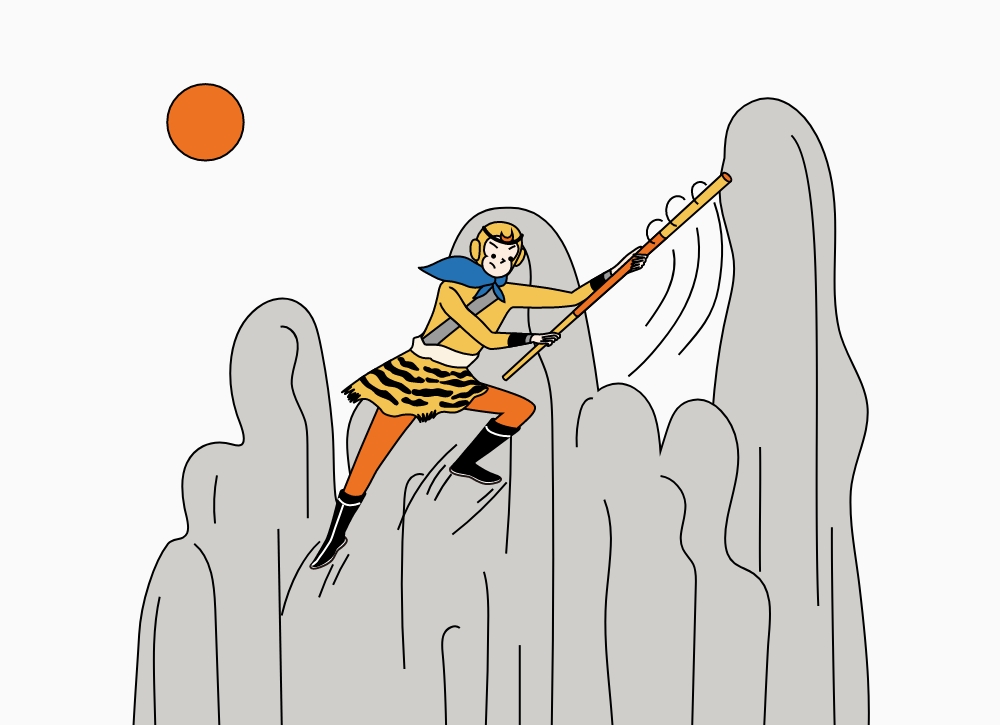
To spark your interest, our guest author Jeff Pepper from Imagin8 Press has shared a brief introduction of the book.
TIP: Scroll the the bottom of the article to discover links to a version of the book written for English-speaking students of Chinese!
Q: What is Journey to the West about?
Journey to the West (西游记, Xīyóu Jì), is a Chinese novel written in the 16th century by Wu Cheng’en (吴承恩, Wú Chéng’ēn).
It is probably the most famous and best-loved novel in China and is considered one of the four great classical novels of Chinese literature. Its place in Chinese literature is roughly comparable to Homer’s epic poem The Odyssey in Western literature. Wikipedia sums up the book’s role perfectly, saying, “Enduringly popular, the tale is at once a comic adventure story, a humorous satire of Chinese bureaucracy, a spring of spiritual insight, and an extended allegory in which the group of pilgrims journeys towards enlightenment by the power and virtue of cooperation.”
Q: Is Journey to the West based on a real story?
The novel’s storyline is loosely based on an actual journey by a Buddhist monk also called Xuanzang who traveled from the city of Chang’an (today’s Xi’an) westward to India in 629 A.D. and returned 17 years later with priceless knowledge and texts of Buddhism.
Q: In short, what is Journey to the West about?
A long time ago, in a magical version of ancient China, the great Tang Empire is ruled by an emperor named Taizong. Due to a mixup involving the wrongful execution of a dragon king, Taizong falls ill, dies, and is dragged down to the underworld. There he comes face to face with the Ten Kings of the Underworld, survives a harrowing journey through hell, and finally escapes with the help of a deceased courtier.
When Taizong returns to the human world he is a changed man. He decides to send a monk to the Western Heaven (that is, India), to visit the Buddha, obtain holy scriptures, and bring them back to the people of the Tang Empire. This task is nearly impossible, requiring the crossing of thousands of miles of wild and dangerous territory. With guidance from the bodhisattva Guanyin, the emperor selects a young monk named Xuanzang.
Xuanzang is a brilliant young man but has a complicated history. In an earlier lifetime centuries before, he was a student of the Buddha but was careless in his studies. Expelled from the Buddha’s temple, he spent the next ten lifetimes meditating and acquiring merit. As an infant in his current lifetime he is nearly killed by bandits, placed in a floating basket by his widowed mother and sent downriver, rescued by a monk, and raised in a monastery. At age eighteen he learns his true history, and goes off to avenge his father’s death.
Later he is chosen by Taizong to undertake the epic journey to the west. Now called Tangseng (“monk from Tang”), he faces a near-impossible task: he must cross hundreds of mountains and thousands of rivers, and survive encounters with a horrifying series of bandits, monsters, demons, ghosts, evil kings, scheming monks, false Buddhas, and much more.
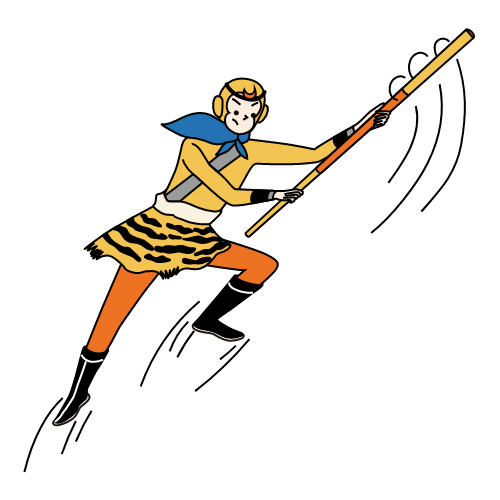
Q: How about the Monkey King and other famous characters?
Tangseng could never survive the journey on his own. Fortunately he acquires three powerful but deeply flawed disciples.
First is the monkey king Sun Wukong (孙悟空, S ūn W ù kōng , his name means “ape awakened to the void”), who he frees from a 500-year imprisonment under a mountain in punishment for creating havoc in heaven.
Second is Zhu Bajie (猪八戒, Zhū Bājiè, “pig of the eight prohibitions”), a gluttonous pig-man who is constantly fighting, and often succumbing to, his desires for food, sex and comfort.
And third is Sha Wujing (沙悟净, Shā Wùjìng, “sand seeking purity”), a reformed man-eating river demon.
All three have been converted to Buddhism by the monk, but they often slip back into their bad habits and cause Tangseng a great deal of trouble. Fortunately they all have great magical powers which come in handy for battling demons and monsters, and saving Tangseng from all sorts of trouble.
The story of this journey is described in this epic novel.

Q: How long is the original book?
The original Journey to the West is a very long book. It contains 100 chapters and is 588,000 Chinese characters long. It uses a very large vocabulary of 4,500 different words, over 90% of which are not included in HSK Levels 1-6, making it quite difficult for most non-native Chinese speakers to read.
The novel is also available in English translation, the best one being by the scholar Dr. Anthony Yu. His version fills four volumes and runs over 2,300 pages.
Q: Is the book suitable for Chinese beginners?
Fortunately for people learning to read Chinese, there is now another way to read this book. My writing partner Xiao Hui Wang and I have spent the last five years writing a series of 31 books that retell the Journey to the West story in language that is accessible to anyone learning to read Chinese at the HSK 3 level. The stories in these books are told in a way that matches the original as closely as possible, but because they are graded readers they are much easier to read. The first book, Rise of the Monkey King, is relatively short and uses just 512 Chinese words. Each book adds more new words and slightly increases the length of the story and complexity of the writing, leading step by step to the longest and most challenging book, Book 31, The Final Trial. All told, the entire series uses about 2,200 different Chinese words excluding proper nouns.
Fortunately, the original novel is not written as a single continuous story, but is broken up into more or less standalone episodes, each one between one and four chapters in length. This makes it possible to read and enjoy any of the 31 graded readers without having to read the ones that came before it.
Each book is written in Simplified Chinese. The books include pinyin, English translation, and a glossary. Free audio versions of each book are available free of charge on YouTube.
Q: Where can I get these books?
A list of all 31 books in the series, along with short descriptions and links to the Amazon product pages and free YouTube audiobooks, can be found on the Imagin8 Press home page, www.imagin8press.com .

by Jeff Pepper
Jeff Pepper ([email protected]) is President and CEO of Imagin8 Press , and has written dozens of books about Chinese language and culture.
Over his thirty-five year career he has founded and led several successful computer software firms, including one that became a publicly traded company. He’s authored two software related books and has been awarded three U.S. patents.
Submit a Comment Cancel reply
Your email address will not be published. Required fields are marked *
Submit Comment
Other posts you might like
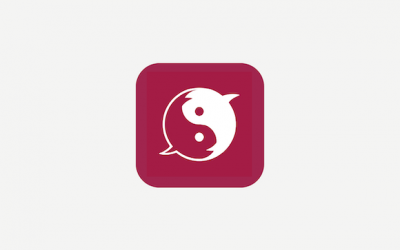
Dong Chinese | Great Tool to Learn Chinese
Sep 13, 2022 | Guest Blogs & Media
The Best Tool to Learn MandarinChinese learning has become extremely popular around the world. One of the reasons why so many people are willing to learn Chinese is that China’s rapid economic growth offers numerous job opportunities to people from different...

Business in Chinese and Chinese Culture
Aug 25, 2022 | Guest Blogs & Media
China is among the leading economic giants in the world. Moreover, the economic, political and social stability coupled with favorable government policies and numerous growth opportunities make it an ideal market for international expansion. However, doing business in...

How Is Social Media Slang Changing the Formal Use of Chinese Language?
Aug 3, 2022 | Guest Blogs & Media
Internet culture has created new words that people sometimes use online. This is the case both for the English-language side of the World Wide Web and for any other corner of it – including the Chinese Internet. Users have been creating new slang words that are...
Get 2-week FREE Chinese Classes
Original Price: ¥ 600

Journey to the West: Volume I
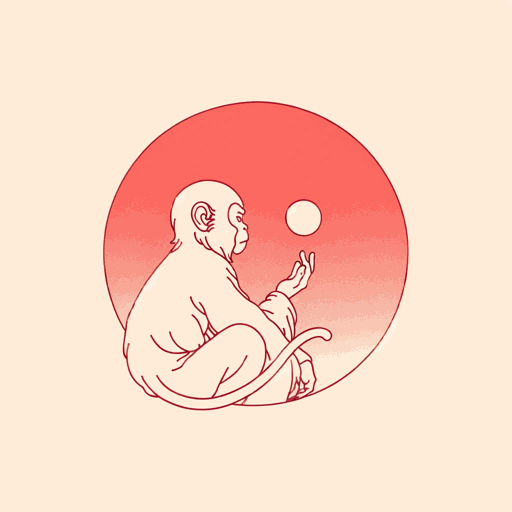
85 pages • 2 hours read
The Journey to the West: Volume I
A modern alternative to SparkNotes and CliffsNotes, SuperSummary offers high-quality Study Guides with detailed chapter summaries and analysis of major themes, characters, and more. For select classroom titles, we also provide Teaching Guides with discussion and quiz questions to prompt student engagement.
Chapter Summaries & Analyses
Chapters 1-5
Chapters 6-10
Chapters 11-15
Chapters 16-20
Chapters 21-25
Character Analysis
Symbols & Motifs
Important Quotes
Essay Topics
Discussion Questions
Chapters 21-25 Chapter Summaries & Analyses
Chapter 21 summary.
Pilgrim fights the wind demon for many rounds. He uses his favorite transformative trick: He plucks out hairs, blows on them, and commands them to change; they each change into doppelgängers of himself. To counter this, the demon summons a hurricane that takes control of all the little monkeys and flings them around. There is only one who can subdue the demon: a bodhisattva named Lingji of Sumeru. Lingji defeats the demon, who reverts to its true form: a brown marten. Pilgrim is about to vanquish the brown marten when Lingji stops him and explains that Tathāgata must see the little rodent. The creature had stolen pure oil and fled because he feared he would get in trouble, and then turned into a demon. Pilgrim and Eight Rules can then rescue Tripitaka.
Get access to this full Study Guide and much more!
- 7,600+ In-Depth Study Guides
- 4,850+ Quick-Read Plot Summaries
- Downloadable PDFs
Chapter 22 Summary

Don't Miss Out!
Access Study Guide Now
Related Titles
By these authors
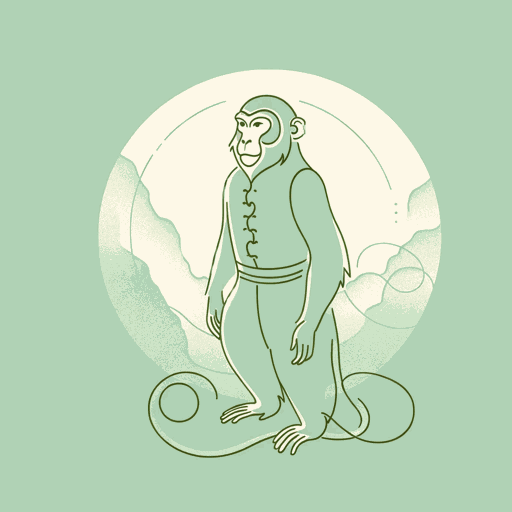
Monkey: A Folk Novel of China
Wu Cheng'en, Transl. Arthur Waley
Featured Collections
Chinese Studies
View Collection
Good & Evil
Order & Chaos
Pride & Shame
Monkey ’s Journey to the West: How Manifold Versions of One Translation Helped to Disseminate a Classic Chinese Original
- First Online: 13 April 2022
Cite this chapter

- Wenyan Luo ORCID: orcid.org/0000-0001-9217-1066 4 &
- Binghan Zheng ORCID: orcid.org/0000-0001-5302-4709 5
Part of the book series: New Frontiers in Translation Studies ((NFTS))
462 Accesses
Many efforts have been made to facilitate the worldwide circulation of Journey to the West , a classical Chinese literary canon. This article studies the dissemination of Journey by focusing on one of its many English translations, namely Monkey: A Folk-tale of China . Monkey was first translated by Arthur David Waley and originally published by George Allen & Unwin in London in 1942. Based on actor-network theory, this research explores the agents that generated, and the dynamics that underpinned the network of translations (different versions of Monkey ), which in turn extensively increased the circulation of the translation ( Monkey ). Discussions will be made based on the correspondence exchanged between a wide range of translation agents participating in the production of the English versions and the many re-translations of Monkey . Supporting data from other sources such as A Bibliography of Arthur Waley (Johns, A Bibliography of Arthur Waley , The Athlone Press, London, 1988) will be referenced where necessary. Through analysing how translation agents assembled, together with necessary resources (i.e. people and material objects), to produce and promote Monkey , the article reveals the very particular and practical translational and material conditions under which the many versions of Monkey were produced and disseminated. The article emphasises that, besides the translator, publishers were crucial in translation production and promotion, and therefore, publisher agencies should not be downplayed in translation studies.
This is a preview of subscription content, log in via an institution to check access.

Access this chapter
- Available as PDF
- Read on any device
- Instant download
- Own it forever
- Available as EPUB and PDF
- Compact, lightweight edition
- Dispatched in 3 to 5 business days
- Free shipping worldwide - see info
- Durable hardcover edition
Tax calculation will be finalised at checkout
Purchases are for personal use only
Institutional subscriptions
Although disputes exist over the authorship of the novel (e.g. Cai 1990 and Wu 2002 ).
The Tang Dynasty is the imperial dynasty that rules ancient China from 618 to 907 CE.
The full number of Indian vernacular languages that Monkey was translated into is not clear.
The same also applies to all versions except for the GA&U edition and its reprints.
Bogic, A. 2010. Uncovering the Hidden Actors with the Help of Latour: The ‘Making’ of The Second Sex . MonTI. Monografías de Traducción e Interpretación , Sin mes, 173–192.
Google Scholar
Cai, T. 1990. 关于百回本 《西游记》作者之争的思考与辩证 [Thoughts and Arguments on the Author of Journey to the West]. Journal of Ming-Qing Fiction Studies Z1: 319–332.
———. 2007. 《西游记的诞生》 [The Origins of Journey to the West]. Beijing: Zhonghua Book Company.
———. 2010. 《西遊記》資料彙編 [A Compilation of Xi You Ji Materials]. Beijing: Zhonghua Book Company.
Callon, M. 1986. Some Elements of a Sociology of Translation Domestication of the Scallops and the Fishermen of St Brieux Bay. In Power, Action and Belief: A New Sociology of Knowledge? ed. J. Law, 196–233. London: Routledge & Kegan Paul Books.
Cao, B. 2010. 《西游记》现存版本系统叙录 (A Systematic Study on the Existent Versions of Journey to the West) Journal of Huaihai Institute of Technology (Humanities & Social Sciences Edition) 8 (10):16–21.
Chen, Q. 2007. 四大名著版本知多少 (The Editions of the Four Chinese Classics). 中国图书商报 (China Book Business Report), Beijing, 21 December 11.
He, M., and S. He. 2016. 《西游记》 的漫漫‘西游’路 (Xi You Ji’s Long ‘Journey to the West’). 中国作家网 (China Writers Net), 19 May. Available at: http://www.chinawriter.com.cn/wxpl/2016/2016-05-19/272630.html [Accessed: 22 March 2021]
Holman, V. 2008. Print for Victory: Book Publishing in Britain 1939–1945 . London: British Library.
Hu, S. 1994. Introduction to the American Edition. In C. Wu Monkey: Folk Novel of China , trans. Waley, A.D., 1–5. New York: Grove Press.
Jia, N. 2012. 《大话西游》 与 《悟空传》 视角下的 《西游记》(Journey to the West in ‘a Chinese Odyssey’ and ‘a Legend of Wukong’). 文教资料 (Data of Culture and Education) 33: 89–91.
Johns, F.A. 1988. A Bibliography of Arthur Waley , 2nd ed. London: The Athlone Press.
Latour, B. 1987. Science in Action: How to Follow Scientists and Engineers through Society . Cambridge, MA: Harvard University Press.
———. 2007. Reassembling the Social: An Introduction to Actor-Network-Theory . New York: Oxford University Press.
Li, X. 2006. 孙悟空形象在明末清初续作中之演变 [The Evolution of the Image of the Monkey in the Sequels to Journey to the West in the Late Ming Dynasty and the Early Qing Dynasty]. Journal of Ming-Qing Fiction Studies 4: 174–184.
Li, R. 2014. Studies on Chinese-English Translation of Proper Name of Journey to the West from the Perspective of Text World Theory. PhD thesis, Shanghai International Studies University, Shanghai.
Liu, Y. 1984. 一部传神的译作——简评亚瑟•威利的《猴子》 [A Vivid Translation: A Brief Review on Arthur Waley’s Monkey]. Chinese Translators Journal 3 (3): 41.
Luo, W. 2020. Translation as Actor-Networking: Actors, Agencies, and Networks in the Making of Arthur Waley’s English Translation of the Chinese ‘Journey to the West’. New York: Routledge.
Morgan, G. 1974. Monkey (Book Review). Asian Affairs 5 (2): 220.
Perlmutter, R. 1971. Arthur Waley and His Place in the Modern Movement Between the Two Wars. ProQuest Dissertations Publishing.
Priest, A. 1943. Monkey (Book Review). Far Eastern Survey 12 (13): 134.
Article Google Scholar
Records of George Allen and Unwin Ltd (UoR AUC), Manuscript Number: MS 3282, University of Reading, Special Collections, Reading.
Stefan, S. 2020. A Tale of Two Translations: Arthur Waley’s and Anthony C. Yu’s Journeys to the West. MA thesis, Nankai University, Tianjin.
TNS Opinion & Social. 2012. Europeans and Their Languages . Special eurobarometer 386, European Commission. Available at: https://ec.europa.eu/commfrontoffice/publicopinion/archives/ebs/ebs_386_en.pdf [Accessed: 18 March 2021]
Turner, W. J. 1942. Monkey (Book Review). The Spectator 169 (5953), 31 July, 109.
Unwin, S. 1960. The Truth About a Publisher: An Autobiographical Record . London: George Allen & Unwin.
Waley, A. 1994. Preface. In The Way and Its Power: Lao Tzu’s Tao Tê Ching and Its Place in Chinese Thought , trans. T. Lao and A. Waley. New York: Grove Press.
Wang, L. 1980. 《西游记》外文译本概述 [An Overview of the Translations of Xi You Ji ]. The Documentation 4: 64–78.
———. 1999.《西游记》在海外 (Journey to the West Overseas). 古典文学知识/The Knowledge of Classical Literature 4: 117–126.
Wang, W., and Y. Li. 2018. A Study on Arthur Waley’s Alteration and Simplification of Xiyouji (Journey to the West) . Journal of Zhejiang International Studies University 1: 68–73.
Wang, X. 2004. 中国小说续书的历史发展 (The Historical Development of Sequels of Chinese Novels). PhD Thesis, Shanghai Normal University, Shanghai.
Wong, L. K. P. 2013. Seeking the Golden Mean: Arthur Waley’s English Translation of the Xi You Ji. Babel , 59 (3): 360–380.
Wu, C. 1994. Monkey: Folk Novel of China , trans. Waley, A. D. New York: Grove Press.
Wu, S. 2002. 究竟谁是造物主: 《西游记》 作者问题综考辨证录 (Who Was the Creator: An Overview of the Existing Thoughts and Analysis on the Author Problem of Journey to the West). Journal of Ming-Qing Fiction Studies 4: 4–28.
Yang, S. 2008. Arthur Waley’s Creatively Treasonous Translation of The Journey to the West . MA Thesis, Capital Normal University, Beijing.
Yao, X. 2006. 古典名著的电视剧改编 [TV Series Adaptations of Classics]. Beijing: CUCP (Communication University of China Publishing).
Yu, A. C. 1977. Preface. In The Journey to the West , trans. C. Wu, A. C. Yu, Vol. 1, ix–xii. London: The University of Chicago Press,
Zheng, J., and Y. Wu 2012. 《西游记》百年英译的描述性研究 (A Descriptive Study on the Translation History of Journey to the West ). Social Sciences in Guangxi 10 (208): 148–153.
Zhu, H. 2012. A Study of the Composition of the Journey to the West from the Perspective of Western Literary Theory. Theoretical Studies in Literature and Art 5: 63–69.
Zhu, M. 《西游记》域外经典化的过程 (The Canonisation of Journey to the West Overseas). Chinese Social Sciences Net, 14 November. Available at: http://econ.cssn.cn/skjj/skjj_jjgl/skjj_xmcg/201611/t20161114_3274582.shtml [Accessed: 21 March 2021]
Zhu, Y., and Y. Liu 1983. 《西游记》资料汇编 [A Compilation of Xi You Ji Materials]. 河南 [Henan]: 中州书画社 [Zhongzhou Shuhua Publishing].
Download references
Acknowledgements
This research is supported by the postdoctoral scheme of the Hong Kong Polytechnic University, and the Project of Technology Consulting Expert, Shanxi Province (山西省科技咨询专家项目).
Author information
Authors and affiliations.
The Hong Kong Polytechnic University, Hung Hom, Hong Kong
Shanxi University, China & Durham University, Durham, UK
Binghan Zheng
You can also search for this author in PubMed Google Scholar
Corresponding author
Correspondence to Binghan Zheng .
Editor information
Editors and affiliations.
Monash University, Clayton, VIC, Australia
Shani Tobias
Rights and permissions
Reprints and permissions
Copyright information
© 2022 The Author(s), under exclusive license to Springer Nature Singapore Pte Ltd.
About this chapter
Luo, W., Zheng, B. (2022). Monkey ’s Journey to the West: How Manifold Versions of One Translation Helped to Disseminate a Classic Chinese Original. In: Qi, L., Tobias, S. (eds) Encountering China’s Past. New Frontiers in Translation Studies. Springer, Singapore. https://doi.org/10.1007/978-981-19-0648-0_6
Download citation
DOI : https://doi.org/10.1007/978-981-19-0648-0_6
Published : 13 April 2022
Publisher Name : Springer, Singapore
Print ISBN : 978-981-19-0647-3
Online ISBN : 978-981-19-0648-0
eBook Packages : Literature, Cultural and Media Studies Literature, Cultural and Media Studies (R0)
Share this chapter
Anyone you share the following link with will be able to read this content:
Sorry, a shareable link is not currently available for this article.
Provided by the Springer Nature SharedIt content-sharing initiative
- Publish with us
Policies and ethics
- Find a journal
- Track your research
Lifelong best friends complete 600-mile journey in motorized toy cars
KEY WEST, Fla. (Gray News) – Two lifelong best friends have just completed a nearly 600-mile journey in motorized toy cars.
Cassie Aran and Lauren Lee, both 29, drove 596 miles from Jacksonville to Key West, Florida – a trek along the entire east coast of the state.
The women began their record-long journey over three months ago and arrived at their final destination in Key West on Saturday.
In a Facebook post , the City of Key West Government posted photos of Aran and Lee celebrating their arrival.
The best friends chronicled their adventure on social media to support their fundraiser aimed at helping animal shelters.
According to a report from WJXT , Aran and Lee were attempting to set a Guinness World Record for “Longest Distance by Toy Cars.”
However, the two will not officially be certified by Guinness World Records because of a financial dilemma.
During their journey, the women received a notification from Guinness that they were “no longer allowed to raise money towards saving animals unless they paid them $16,000,” according to Aran.
Although they said it was heartbreaking to give up their dream of holding a Guinness World Record, the women said it was far more important to them to donate the money they raised to animals in need.
So, they forfeited the Guinness title.
“We are so incredibly sad that we had to make the decision to choose between the record title and saving animals...but I know we made the right move,” Aran said in a post on her YouTube Channel . “I hope so many animals get saved from kill shelters and get the life they deserve because of this very sad decision. I hope you guys will still stay here for our 600-mile journey to the finish line in Key West. I love you guys and I’m going to go cry now..but I still stand by my decision 1000%.”
Aran and Lee have been best friends since kindergarten. They said the toy car journey was a way to honor their childhood memories, as they used to ride them around the neighborhood growing up together.
The women told WJXT that the adventure was so much fun that they plan on taking another long journey in toy cars again soon.
Copyright 2024 Gray Media Group, Inc. All rights reserved.

6 arrested in deadly Blytheville shooting

Many customers without power in Region 8

Massage therapist sentenced to 20 years for rape

Man accused of punching doctor

Rollover crash on I-555 cleared after nine hours
Latest news.

Man accused of threatening to kill people over not getting a hamburger

Legislature in gridlock with AGFC regarding funding

Cicada scavengers urged to keep eyes peeled for other hunters

College holds graduation for graduates’ pets

Judge directs Michael Cohen to keep quiet about Trump ahead of his hush money trial testimony
This page uses technologies your browser does not support.
Many of our new website's features will not function and basic layout will appear broken.
Visit browsehappy.com to learn how to upgrade your browser.

- university of new orleans
- campus news
- college sports executive kiki baker barnes tells uno graduates be
CAMPUS NEWS: MAY 10, 2024
Commencement 2024, college sports executive kiki baker barnes tells uno graduates be ‘ready to embrace the unexpected’.
Share this article

College sports executive and University of New Orleans alumna Kiki Baker Barnes gave the commencement address at the University’s spring 2024 commencement ceremony held Thursday, May 9.
College sports executive and University of New Orleans alumna Kiki Baker Barnes, who holds both a bachelor’s degree and doctorate from UNO, knew without a doubt that she was a spectacular shooting guard. She’d excelled at the position all through high school, which is why she balked when her junior college basketball coach suggested she move to point guard.
The move felt like a setup for failure because handling the ball under pressure wasn’t her strength, Baker Barnes said Thursday at UNO’s Lakefront Arena where she delivered the keynote address during the spring commencement ceremony.
“This wasn’t just a change in position,” Baker Barnes said. “It was a transformation in role and mindset.”
She resisted—despite her coach’s insistence that her height and quickness would make her a formidable point guard and could help get her to the next level of the game.
She complained—repeatedly—to herself, said Baker Barnes who, in 2022, became the first African American woman commissioner in the history of the Gulf Coast Athletic Conference and in any conference in the history of the National Association of Intercollegiate Athletics, an association founded in 1937 that includes more than 250-member institutions.
Her recurring complaint: “I don’t see why he’s making me do all of this. It’s not like there is a professional basketball league for women in the United States,” Baker Barnes recalled.
When Baker Barnes graduated high school in 1993, the WNBA did not exist. Her coach relented and moved her back to her more comfortable post of shooting guard.
Fast forward to 1997 when Baker Barnes had just completed her undergraduate degree at UNO, as well as a stellar collegiate basketball and track career. She was offered a tryout with the WNBA, the new women’s professional basketball league that would debut that year.
“I was ecstatic,” Baker Barnes said. “I made it through the first round of cuts. I was playing some of my best ball!”
She was cut in the second round and was devastated. Her college coach would tell her later that the scouts thought she was skilled, quick and athletic. However, they were looking for a point guard, Baker Barnes said.
She encouraged graduates to take three pivotal lessons from her story.
“First, understand that just because an opportunity isn’t visible right now, doesn’t mean it won’t emerge,” Baker Barnes said. “Let this inspire you to pursue your dream with an open heart and an eager mind, always ready to embrace the unexpected.”
Second, remember that preparation is your most reliable guide through the unknown, Baker Barnes said.
“Equip yourself not just for the paths you anticipate, but also for the unforeseen challenges that may arise,” she said.
Lastly, she urged graduates to embrace failure as a necessary chapter in their success story.
“The true test is not in avoiding failure but in how you respond to it … How you choose to move forward from these moments will shape your journey and define your legacy,” Baker Barnes said.
“Graduates … step boldly into the future, prepared for the unknown, resilient in the face of setbacks and always eager to turn hidden opportunities into triumphs.”
The 2024 graduating class hailed from 32 U.S. states and territories and 32 areas abroad.
During the commencement, UNO President Kathy Johnson presented Baker Barnes with a medallion as a symbol of the University’s gratitude and applauded the graduates for their perseverance.
“My deepest hope is that your education at the University of New Orleans will enable you to help change our world for the better as you enter into this next phase of your life, whether that entails a career, more school or public service,” Johnson said.
The next step for music studies major Kalif Brown is going on tour with entertainer Robin Barnes and the Fiya Birds, he said.
“I play drums, piano and I sing,” Brown said.
But first, he had to keep a promise to his mother and collect his college diploma, said Brown, who carried a mortar board decorated with family photos.
“This is everybody who has helped me get to this point so far. You see a lot of pictures of my mom on here, that’s because my mom had me at 16 years old and I know I made (her life) a little more complicated,” Brown said. “One thing she always said is that she wanted to see me walk across the stage, and I promised her that I would do that.”
Meanwhile, Julia Mai plans to parlay her bachelor’s degree in biological sciences to become a physician assistant. Mai, who started a pre-PA club at UNO, is headed to graduate school to pursue a Master of Physician Assistant Studies.
Mai said she’s excited for what the future holds for her and for the future of the career support organization she helped to start.
“I want to express my gratitude to Dr. Michael Doosey for not only being the best club adviser ever, but for also being a huge advocate for the club since the start,” Mai said. “I look forward to seeing what the future holds for the UNO Pre-PA Club!”
English major Whittinee Cox’s mortar board perhaps proclaimed a sentiment held by many of the graduates as they laughed and posed for selfies in groups, in front of their college banners and solo. The glittery mortar board stated: “There ain’t nothing gonna stop me NOW!”

St. Claude Gallery Exhibits ‘Beyond Family’ by UNO Professor Ariya Martin
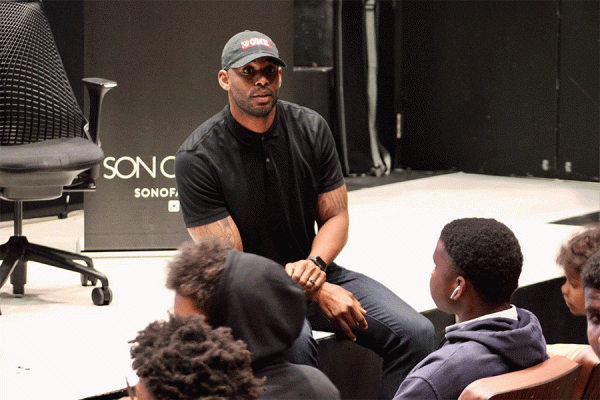
Former New Orleans Saints Players Team with UNO To Offer Financial Education Course To High School Students
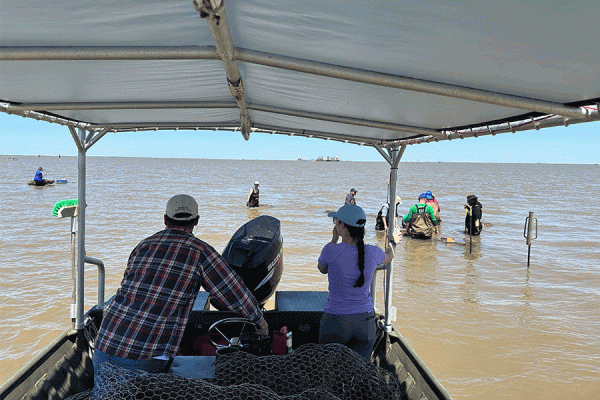
UNO Class Uses Wreaths To Fight Coastal Land Erosion

IMAGES
VIDEO
COMMENTS
Journey to the West (Chinese: 西遊記; pinyin: Xīyóujì) is a Chinese novel published in the 16th century during the Ming dynasty and attributed to Wu Cheng'en.It is regarded as one of the greatest Classic Chinese Novels, and has been described as arguably the most popular literary work in East Asia. Arthur Waley's 1942 abridged translation, Monkey, is known in English-speaking countries.
Journey to the West, foremost Chinese comic novel, written by Wu Cheng'en, a novelist and poet of the Ming dynasty (1368-1644). The novel is based on the actual 7th-century pilgrimage of the Buddhist monk Xuanzang (602-664) to India in search of sacred texts. ... Composed of 100 chapters, the novel can be divided into three major sections
Chapter. Summary. Chapters 1-3. In the small country of Ao-lai, a rock splits open to reveal a stone egg that transforms into a living stone monkey. M... Read More. Chapters 4-7. The Spirit of the Planet Venus takes Monkey to Heaven, where he is assigned to the stables. At a feast celebrating his...
Journey to the West, a monumental novel composed of one-hundred chapters loosely divided into four sections, depicts the spiritual journey of Tripitaka, a Buddhist monk striving to retrieve lost ...
Journey to the West is a classic Chinese mythological novel. It was written during the Ming Dynasty based on traditional folktales. Consisting of 100 chapters, this fantasy relates the adventures of a Tang Dynasty (618-907) priest Sanzang and his three disciples, Monkey, Pig and Friar Sand, as they travel west in search of Buddhist Sutra.
The Journey to the West: Volume I (1983), translated and edited by Anthony C. Yu, contains the first 25 chapters of a 100-chapter hero's epic, an allegory designed to impart knowledge on how to behave and what values to extol. Originally published in the late 16th century during the late Ming Dynasty, this epic is "loosely based on the famous pilgrimage of Xuanzang…the monk who went from ...
Journey to the West is a fictionalized account of the legends surrounding the 16-year pilgrimage of the Buddhist monk Xuánzàng (602-664) to India during the Táng dynasty, to obtain Buddhist religious texts (sutras).Xuánzàng reached India after experiencing innumerable trials and hardships. He lived there for more than a decade, studying classics of Buddhism and Indian culture at Nalanda ...
Journey to the West Journey to the West - Read the Text Read the Excerpt. Journey to the West Monkey By Wu Ch'êng-ên, translated by Arthur Waley Evergreen Books, 1994 . Chapter 1. There was a rock that since the creation of the world had been worked upon by the pure essence of Heaven and fine savours of Earth, the vigour of sunshine and ...
First published in 1952, The Journey to the West, volume I, comprises the first twenty-five chapters of Anthony C. Yu's four-volume translation of Hsi-yu Chi, one of the most beloved classics of Chinese literature. The fantastic tale recounts the sixteen-year pilgrimage of the monk Hsüan-tsang (596-664), one of China's most illustrious religious heroes, who journeyed to India with four animal ...
Chapter 1 Summary. The first human, Pan Gu, is born of yin (the feminine, dark, negative) and yang (the masculine, light, positive) and makes order by separating good and bad. Yang awakens, and so does Yin. A divinely bred monkey, with yin and yang and magic, along with the essences of the universe, is born from a stone.
Journey to the West, or Xiyouji (西游记), is a late Ming dynasty (1368-1644) novel of comedic fantasy based on the religious pilgrimage of a 7th-century Chinese Buddhist monk to India in search of religious scripts. Published in the late 16th century, with the earliest extant edition dating back to 1592, Journey to the West is a hundred-chapter novel attributed to the author Wu Cheng'an.
The distance, scholars believe, is like walking from Maine to California, only you'd have to cross an enormous desert and the Himalayan Mountains, home to Mt. Everest (and much taller than the Rocky Mountains). The land at Hsuan Tsang's time was mostly unmapped, and early listeners to the stories that would make up Journey to the West might ...
First published in 1952, The Journey to the West, volume I, comprises the first twenty-five chapters of Anthony C. Yu's four-volume translation of Hsi-yu Chi, one of the most beloved classics of Chinese literature. The fantastic tale recounts the sixteen-year pilgrimage of the monk Hsüan-tsang (596-664), one of China's most illustrious religious heroes, who journeyed to India with four animal ...
First published in 1592, The Journey to the West, volume I, comprises the first twenty-five chapters of Anthony C. Yu's four-volume translation of Hsi-yu Chi, one of the most beloved classics of Chinese literature.The fantastic tale recounts the sixteen-year pilgrimage of the monk Hsüan-tsang (596-664), one of China's most illustrious religious heroes, who journeyed to India with four animal ...
Journey to the West Summary. The novel's 100 chapters are divided into four uneven parts, each containing a collection of largely unrelated histories and folktales threaded into a single narrative ...
Monkey is an abridged translation of Hsi-yu chi (Xiyouji), or The Journey to the West. The original Chinese version of the novel has 100 chapters, which British translator Arthur Waley (1889-1966) cut down to 30 for Monkey. Everything he removed from the original version of the book deals with Tripitaka's journey from China to India.
Journey to the West The powerful and mischievous Stone Monkey King brings chaos to heaven and earth. Freed from a mountain prison in order to guard a Chinese monk on his journey to retrieve the Buddhist scriptures from India, Monkey seeks his own spiritual transformation. ... Over the course of the full set of 81 adventures over 100 chapters in ...
The original Journey to the West is a very long book. It contains 100 chapters and is 588,000 Chinese characters long. It uses a very large vocabulary of 4,500 different words, over 90% of which are not included in HSK Levels 1-6, making it quite difficult for most non-native Chinese speakers to read.
Chapter 21 Summary. Pilgrim fights the wind demon for many rounds. He uses his favorite transformative trick: He plucks out hairs, blows on them, and commands them to change; they each change into doppelgängers of himself. To counter this, the demon summons a hurricane that takes control of all the little monkeys and flings them around.
Chapter 19 finds the pilgrims at the Treasure Wood Temple in the Kingdom of Crow-cock, where the ghost of a former king visits Tripitaka in a dream. Five years ago, the realm suffered a terrible drought. The king enlisted the help of a magician who made it rain and helped the kingdom become prosperous once again.
Nov 24, 2023 11:32 AM EST. Journey to the West Analysis. The tale of Monkey and his journey deep into the Buddhist heartland of India is an elaborate tale filled with adventure, allegory, and spiritual insight. Monkey tricks his way in and out of many stressful situations. He is a deviant, mischievous little fellow who can never be trusted.
Many efforts have been made to facilitate the worldwide circulation of Journey to the West, a classical Chinese literary canon.This article studies the dissemination of Journey by focusing on one of its many English translations, namely Monkey: A Folk-tale of China.Monkey was first translated by Arthur David Waley and originally published by George Allen & Unwin in London in 1942.
General Juan Lian/Curtains?, Golden Cicada, if you can still remember these characters, join them on their path to obtain the sutras, if you can't remember, then begin reading, join them on their magical/mystical journey with all kinds of evil forces!
KEY WEST, Fla. (Gray News) - Two lifelong best friends have just completed a nearly 600-mile journey in motorized toy cars. Cassie Aran and Lauren Lee, both 29, drove 596 miles from Jacksonville ...
Lastly, she urged graduates to embrace failure as a necessary chapter in their success story. "The true test is not in avoiding failure but in how you respond to it … How you choose to move forward from these moments will shape your journey and define your legacy," Baker Barnes said. "Graduates … step boldly into the future, prepared ...